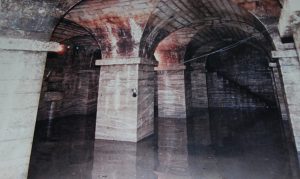The spring: Reine Jeanne d’Oraàs (Queen Jeanne d’Oraàs)
Today the saltwater spring in the Bayaà square at Salies-de-Béarn is no longer used. The spring of Queen Jeanne d’Oraàs is the one that feeds the Saltworks at Salies-de-Béarn.
Discovered in 1830, it was first used by the Compagnie Thore, which then became the property of the Parts Prenants of the Saltwater spring of Salies-de-Béarn.
In 1891, the Academy of Medicine authorised the saltwater for medicinal purposes at the Thermal Establishment, which was receiving growing numbers of visitors. For this purpose an eight kilometre pipe was built to take water from the spring of Queen Jeanne d’Oraàs to the Saltworks of Salies-de-Béarn.
Spring water with exceptional qualities
 Over and above the remarkable concentration of sodium chloride, water from the spring of Queen Jeanne d’Oraàs contains a total of 26 minerals and trace elements.
Over and above the remarkable concentration of sodium chloride, water from the spring of Queen Jeanne d’Oraàs contains a total of 26 minerals and trace elements.
The analysis of a litre of water from the spring includes the following:
- More than 300g of sodium chloride
- 1500 mg of potassium
- 1300 mg of calcium
- 700 mg magnésium
- 11 mg of iron
- 3 mg of manganese
- 1.3 mg of zinc.
Since the 19th century, saltwater from the area around Salies-de-Béarn has been used for its health benefits.
The evaporation of saltwater: know-how handed down for generations

Recovering Coarse Salt
Even if the Saltworks has had the benefit of technological advances down the ages, the extraction technique for salt is still crystallisation through the evaporation of water. Drawn directly from the spring of Queen Jeanne d’Oraàs, the water is taken down an eight-kilometre pipe.
It is then heated slowly in a saltpan: under the effect of heat, the water evaporates and the salt crystallises.

 FRA
FRA DEU
DEU ESP
ESP JPN
JPN
